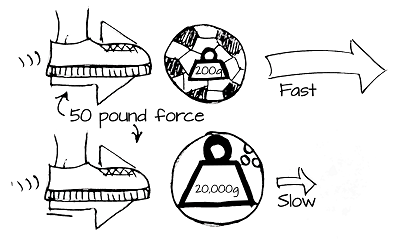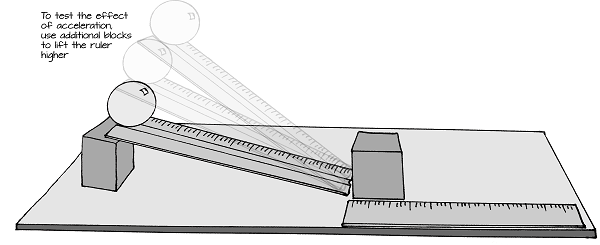Mass and Acceleration
When an object changes its speed, it’s called acceleration. The larger the change in speed, the larger the acceleration. We can also predict how much the soccer ball will accelerate during the kick if we know something about the soccer ball: its mass. Mass is the amount of matter in an object. A bowling ball has more matter in it than a soccer ball, therefore the bowling ball has more mass than the soccer ball:

If you apply the same kick to both the soccer ball and the bowling ball, the soccer ball will speed up much more than the bowling ball during the kick (don’t try kicking a bowling ball - you could break your foot!) When mass increases, acceleration decreases. We can represent this as:

For the same force, a large mass only accelerates a small amount, and a small mass will accelerate a large amount:


Your Turn
The following experiement will help you understand the relationship between force, mass, and acceleration. To do this experiment, you will need the following materials:
- 3 balls or marbles of different weights
- 2 rulers
- 4 blocks (dice work well)
Effect of force on mass:

- Arrange the setup as illustrated in the diagram above. Place one end of the ruler on top of a block and then place one block at the lower end of the ruler. Place the other ruler next to the block as shown.
- Release the marble from the top of the ruler.
- Record how far the block at the bottom moves when hit.
- Add another block to the bottom as shown in the diagram. Release the marble from the top of the ruler and record the distance traveled by the blocks again.
- Repeat the procedure with a third block.
Observe that when mass is increased, the same force cannot accelerate (and therefore move) the blocks as far. Increasing the mass decreases the acceleration.
Effect of force on acceleration:

- Use the same setup as before.
- Release the marble from the top of the ruler.
- Note the distance by which the lower die moves.
- Add another block to raise the starting height of the ruler. Release the marble from the top of the ruler and record the distance traveled by the block again.
- Repeat the procedure with a third block.
Observe that the block moves the longest distance when the ruler's incline is steepest. This is because the steepness of the ruler increases the acceleration of the ball, which in turn increases the force it can apply to the block.
Can you think of additional ways to test the relationship between force, mass and acceleration?
Educators - Additional resources are available on Khan Academy: One-dimensional motion, Two-dimensional motion and Forces and Newton’s Laws of motion. Also, search online for "F=ma practice problems" to find additional worksheets, problems, and projects.
